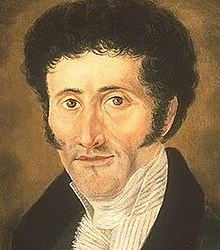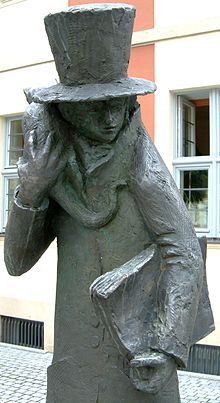Ernst Theodor Amadeus Hoffmann

Ernst Theodor Amadeus Hoffmann (born Königsberg 24 January 1776; died Berlin 25 June 1822) was a German writer, composer, music critic, painter, caricaturist and lawyer. He liked the music of Wolfgang Amadeus Mozart so much that he changed his third name from Wilhelm to Amadeus. He is always known as E. T. A. Hoffmann. He was a man of many talents, but his greatest importance is as a Romantic writer. He wrote fantasy and horror stories which had a very large influence on German literature in the 19th century. His stories had a lot of influence in music. He is the hero of Jacques Offenbach's famous opera The Tales of Hoffmann. His fantasies were used in other musical works such as Delibes’s ballet Coppélia and in operas by Busoni and Hindemith.
Life
[change | change source]Early years
[change | change source]
Hoffmann studied law at the University of Königsberg from where he graduated when he was only 16 years old. He finished his studies in Glogau and Berlin. His first job was in Posen. He married in 1802. In the same year he had to leave his job because he had made fun of some people in his caricature drawings. He soon went to Warsaw where he worked as a lawyer as well as meeting famous writers. He composed music, including a symphony, a harp quintet and music for plays. Because of the political situation after the French invasion in 1806 he lost his job. He tried to get a job in Berlin but without success. In 1808, he went to Bamberg where he spent five years. His job there was as a conductor and theatre designer. He fell in love with a young girl called Julia Marc and composed sacred music and operas. He wrote musical criticism as well as stories for the newspaper Allgemeine Musikalische Zeitung. These include the famous short stories Ritter Gluck, Don Juan and the series called Kreisleriana (Johannes Kreislers, des Kapellmeisters musikalische Leiden, i.e. The musical suffering of the Director of Music Johannes Kreisler).
Later career
[change | change source]
In 1813, he left Bamberg and spent some time in Dresden, Leipzig and, from 1814 onwards, Berlin. He was an excellent lawyer and was able to work very sensibly as a court official while, at the same time, spending some time devoted to art. He often met with literary friends to discuss literature and wrote more stories including Die Lebensansichten des Katers Murr (Tom-cat Murr’s views on life). His health started to become poor. He suffered from creeping paralysis. Once again he got into trouble because of his satire, but before his punishment could be sorted out he fell ill and died.
His stories
[change | change source]Hoffmann wrote various kinds of stories. Some of them are about fate, e.g. Elixiere des Teufels which is about a Capuchin monk who is tempted by the drink offered by the devil. Some of them are fairy tales, e.g. Der goldene Topf (The golden pan) and Nussknacker und Mausekönig (Nutcracker and Mouse King). Very often in these stories the supernatural meets everyday reality. Some of his stories are autobiographical because they fantasies about himself. In particular, the story about Kreisler became very popular and was used by musicians, e.g. Robert Schumann in his piano pieces called Kreisleriana.
Hoffmann is one of the great writers of German prose. He brought his imaginary world to life with his Romantic characters.
